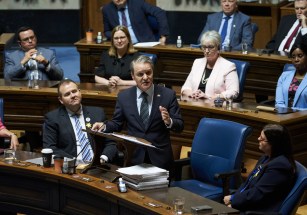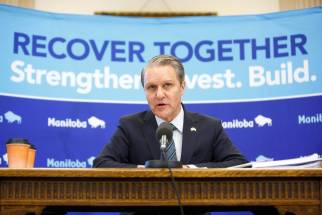Flush with cash, Tories decide to skimp out on hospitals — again
Read this article for free:
or
Already have an account? Log in here »
To continue reading, please subscribe:
Monthly Digital Subscription
$0 for the first 4 weeks*
- Enjoy unlimited reading on winnipegfreepress.com
- Read the E-Edition, our digital replica newspaper
- Access News Break, our award-winning app
- Play interactive puzzles
*No charge for 4 weeks then price increases to the regular rate of $19.00 plus GST every four weeks. Offer available to new and qualified returning subscribers only. Cancel any time.
Monthly Digital Subscription
$4.75/week*
- Enjoy unlimited reading on winnipegfreepress.com
- Read the E-Edition, our digital replica newspaper
- Access News Break, our award-winning app
- Play interactive puzzles
*Billed as $19 plus GST every four weeks. Cancel any time.
To continue reading, please subscribe:
Add Free Press access to your Brandon Sun subscription for only an additional
$1 for the first 4 weeks*
*Your next subscription payment will increase by $1.00 and you will be charged $16.99 plus GST for four weeks. After four weeks, your payment will increase to $23.99 plus GST every four weeks.
Read unlimited articles for free today:
or
Already have an account? Log in here »
Hey there, time traveller!
This article was published 12/04/2022 (1337 days ago), so information in it may no longer be current.
It’s hard to fathom how the Stefanson government could only find $105 million in new health care funding in its 2022 budget, given the windfall of cash the province expects this year.
Revenues are projected to grow a staggering $1.5 billion in the fiscal blueprint unveiled by the Tories Tuesday – an 8.5 per cent increase over last year. The biggest chunk of that new money is from the federal government ($610 million) and the rest is from own-source revenues (including $503 million in corporation and income tax revenues).
Despite that, health care spending will only rise a paltry 1.6 per cent this year, to $6.687 billion from $6.582 billion. It’s not much considering the massive surgical and diagnostic backlog, the severe shortage of front-line staff, and the record wait times in hospital emergency rooms.
The province announced an additional $110 million to reduce surgical and diagnostic wait times, on top of the $105-million increase in health care spending (it’s a separate line in the budget listed under “enabling appropriations”).
Still, it’s a pittance in a health care budget of almost $7 billion. It won’t even keep up with inflation.
Still, it’s a pittance in a health care budget of almost $7 billion. It won’t even keep up with inflation.
For reasons that are difficult to comprehend (both politically and from a public policy perspective), this government has an aversion to giving hospitals sustainable funding.
Whether it was before the COVID-19 pandemic or during, funding for acute care services has not even kept pace with inflation. This year is no different.
In 2017-18, the year the Progressive Conservative government consolidated hospitals in Winnipeg, the budget for acute care services (which includes money for salaries, supplies, drugs and other operating costs to run hospitals) was $2.458 billion. It was largely unchanged the next year at $2.467 billion when regional health authorities were tasked with finding $83 million in savings.
In 2019-20, the year before the pandemic, the budget for acute care services was $2.512 billion. It was whittled down to $2.495 billion the next year.
This year it’s $2.525 billion, 2.7 per cent higher than it was five years ago. Even with the additional $110 million earmarked for surgical and diagnostic wait times, that’s a 7.2 per cent increase over five years, well below the rate of inflation. In real dollars, it’s a cut. It doesn’t even begin to cover the costs of Manitoba’s growing and aging population, nor the effects of the pandemic.
Hospitals have been starved for cash for the past six years. It’s not because the government has lacked revenues. Federal transfers alone have increased by $1.46 billion over the past five years, including a $276-million increase in the Canada Health Transfer. Much of that money has gone into tax cuts and deficit reduction, laudable policy choices during more favourable times, but hardly top priorities for most Manitobans right now. The government’s own pre-budget consultations showed that fixing health care was far and away the top priority of most Manitobans. Cutting taxes and reducing the deficit were at the bottom of the list.
Chronic underfunding causes long-term, systemic problems that lead to hospital overcrowding, backed-up emergency departments and growing wait lists for surgery and diagnostic services.
Chronic underfunding of hospitals has led to a lack of capacity, including a shortage of staffed hospital beds. It has robbed hospitals of the ability to absorb the influx of COVID-19 patients and forced regional health authorities to cancel more surgeries than they would have, had hospitals been adequately funded. There’s a reason Manitoba was forced to airlift 57 ICU patients to other provinces during the third wave of the pandemic last year.
Hospitals can adjust and respond to surges in patient demand in the short term. But chronic underfunding causes long-term, systemic problems that lead to hospital overcrowding, backed-up emergency departments and growing wait lists for surgery and diagnostic services. That can’t be solved overnight, especially after a crisis such as a pandemic. However, continuing to underfund hospitals, as this year’s budget does, will prolong the problem.
Most Manitobans want the government to fix health care and bring down record wait times. Few are clamouring for tax cuts, especially while the books remain in the red. It’s stunning the government has so much trouble getting its head around that.
tom.brodbeck@freepress.mb.ca

Tom has been covering Manitoba politics since the early 1990s and joined the Winnipeg Free Press news team in 2019.
Our newsroom depends on a growing audience of readers to power our journalism. If you are not a paid reader, please consider becoming a subscriber.
Our newsroom depends on its audience of readers to power our journalism. Thank you for your support.



.jpg?w=100)








